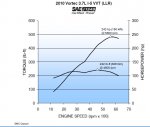Okay, but why would you want peak torque when you're cruising on the highway? And if that were the case, there would be absolutely no point in shifting past 2500 rpms. For example, my engine peaks at 3000 rpm. Past that, my motor actually feels kind of breathless, so I rarely go past 4000 rpm.
The ideal situation is to have torque peak very low, but then to remain at about the same level until close to redline.
That, btw is what variable valve timing (such as Honda's VTEC) does.
Small engines make their peak torque at very high rpms, and are gutless at low rpms. VTEC optimizes valve timing and lift to flatten out the valve timing so that you get good torque numbers at both low and high rpms.
Conversely, large engines make a lot of torque down low, but can lose steam in the higher rpms. valve timing would have an effect here, by giving your higher rpms some usefulness.
At one point, BMW was experimenting with infinitely variable valve timing. Instead of using cam shafts to open the valves, they were using solenoids. They could open/close the valves as much and when they wanted to. I think they had problems with reliability, though.













